| Liberation 1944 (Playbook edition):
The German Army, Part One
By Mike Bennighof, Ph.D.
October 2024
 Panzer Grenadier: Liberation 1944 is based on the British return to France in 1944, where they face determined German opposition. The German garrison is a decidedly mixed bag, ranging from “East” battalions made up of extremely unwilling conscripted foreigners to battle-tested panzer divisions recuperating from their time on the Eastern Front. Panzer Grenadier: Liberation 1944 is based on the British return to France in 1944, where they face determined German opposition. The German garrison is a decidedly mixed bag, ranging from “East” battalions made up of extremely unwilling conscripted foreigners to battle-tested panzer divisions recuperating from their time on the Eastern Front.
On the other hand, these German formations had four years to plan and prepare for an Allied return to the Continent, and most of their divisions had at least a cadre with combat experience on the Eastern Front (though sometimnes this ju8st meant they were burned out and unwilling to fight yet another campaign).
Here’s a look at what the German regular army brings to the battlefield.
Infantry
  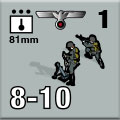 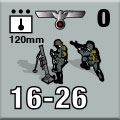
The standard German late-war grenadier platoon numbered (on paper at least) 32 men organized in three nine-man squads with a five-man command element (an officer or senior NCO commanding the platoon, plus runners, stretcher bearers and wagon drivers). Each squad had its own light machine gun, but the platoon no longer included the useless 50mm light mortar.
Riflemen carried the bolt-action Mauser Karabiner 98k as their standard rifle, with a scattering of semi-automatic Gewehr 43 rifles (officially 19 of them per three-platoon company, but some units had fewer, and favored units had more). Each squad leader and his assistant were issued an MP40 submachine gun as well, so roughly half of the soldiers in a full-strength grenadier platoon wielded an automatic weapon of some sort.
In late 1943, German infantry began receiving Panzerfaust shaped-charge anti-tank rockets, giving them some anti-tank capability. These did not require a great deal of training to use and were cheap to manufacture. Several million were eventually issued.
In addition to the squad-level machine guns, the grenadier battalion included a machine gun company of three platoons, later modified to spread the machine guns among the battalion’s three rifle companies. These “heavy” machine guns were the same weapon as that carried by the squad-level machine gunners (the MG34 or MG42) but with a tripod mount, extra barrels and plenty of ammunition. Plus the company had its own dedicated supply train to keep these items flowing to the gunners.
Additional firepower came from 81mm medium and 120mm heavy mortars. In the 1943 scheme each rifle company had its own section of 81mm mortars, with a section of the 120mm weapons attached to the machine gun company. By the middle of 1944 the mortars had all been concentrated in a single company, since most battalion commanders preferred to operate them together anyway.
The German 81mm mortar, known as the Granatwerfer 34, was a copy of the French Brandt Mle27 mortar made by Rheinmetall-Borsig and very similar to copies built by many other countries. The 120mm Granatwerfer 42 was also a copy, this time of the Soviet M1938 (which was itself a licensed copy of a Brandt design). The Germans also made use of many captured Soviet weapons. The 81mm mortar could be carried by its crew; the 120mm weapon theoretically could be as well but more often its two-wheeled axle was attached so it could be towed instead.
Anti-Tank Guns
 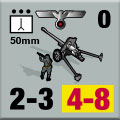 
The standard German anti-tank gun of 1944 is the 75mm PAK 40, a very capable weapon that can deal with any tank in the British inventory. It’s a heavy piece for its size, but it’s not enough of a difference to signify in game terms. Rheinmetall-Borsig and its licensed partners built over 20,000 of them during the course of the war.
The PAK 40 was pretty much a scaled-up version of its predecessor, the 50mm PAK 39 (thus the excessive weight). Rheinmetall-Borsig made over 9,000 of them, and many remained in service until the end of the war. They could still destroy most of the Western Allies’ most common tanks, though not as effectively as their larger sibling.
Daily Content includes no AI-generated content or third-party ads. We work hard to keep it that way, and that’s a lot of work. You can help us keep things that way with your gift through this link right here.
The biggest German anti-tank gun deployed in numbers, the 88mm PAK41/43 (shortened to 88/43 on the playing piece) was a monstrous weapon. Gun crews could only handle it with difficulty, dubbing it the “barn door.” But when it could be pointed at the enemy, it could punch holes in whatever tank crossed its path, and do so at great distances.
Krupp adapted the anti-tank gun from its failed entry into the competition for a second-generation 88mm anti-aircraft gun (the Krupp gun lost out to Rheinmetall-Borsig, whose winning weapon turned out to be overly complex to maintain and prone to jamming). Ordered to use as many existing components as possible, Krupp mounted the barrel on the carriage from the 105mm leFH 18 howitzer. Over 2,000 were built.
Artillery
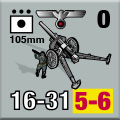 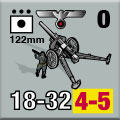 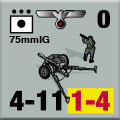
The leFH 18 howitzer appears in many Panzer Grenadier games and supplements. The backbone of German divisional artillery, each division was allotted two or three dozen of these depending on the type of division. Their effect in Panzer Grenadier games usually comes in the form of off-board artillery (those 16-strength increments), but on occasion they did show up in close proximity to the enemy and so they are on the board in some scenarios. Counting variant models, Rheinmetall-Borsig made over 7,000 of them.
Even so, German artillery production did not meet the demands of the field army plus fortifications, and after the sneak attack on the Soviet Union in June 1941 the Germans captured and put to use hundreds of former Red Army field pieces. The 122mm corps howitzer came in several models, and the Germans issued over 400 of them to their own troops as both a medium and heavy piece, and put 122mm ammunition into production in their own factories.
The 75mm infantry gun continued to serve as a regimental piece, with six of them assigned to each infantry regiment’s gun company. When the Army reduced infantry regiments from three grenadier battalions to two, the number of infantry guns remained the same. Regimental commanders could keep the guns together for fire support, but more commonly parceled them out among the grenadier battalions.
Anti-Aircraft
 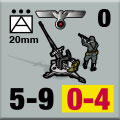
The German Army went to war with a large anti-aircraft component, with light guns normally manned by the Army and heavy ones by the Air Force. By 1944, German infantry divisions (on paper at least) had a flak company of a dozen 20mm guns, while panzer divisions added a dozen 88mm guns. Both weapons also appeared in independent formations.
Rheinmetall-Borsig produced over 100,000 of the 20mm Flak38 (Fliegerabwehrkanone, sometimes Flugabwehrkanone), with the weapon remaining in service despite the Army’s desire to replace it with the much more effective 37mm Flak43. The 20mm weapon had a relatively low rate of fire compared to similar guns produced in other countries, but still gave the troops anti-aircraft cover and it could also be used in ground combat as a very heavy machine gun with limited anti-tank capability.
Imperial Germany had produced an 88mm anti-aircraft gun, and in the late 1920’s Krupp brought out an improved model that saw action with German troops during the Spanish Civil War. Experience there led to a number of improvements, including provision of high-explosive and armor-piercing ammunition for use against ground targets and vehicles.
The gun proved very effective in all of those roles, including anti-aircraft defense. Its high silhouette made it vulnerable in ground combat, but until the end of the war it could destroy any Allied tank at great ranges.
And that’s it for the Wehrmacht weapons and foot soldiers. Later we’ll take a look at the German Army’s weird array of tanks and armored vehicles, and at the Waffen SS.
You can order Liberation 1944 right here.
Please allow an extra two weeks for delivery.
Sign up for our newsletter right here. Your info will never be sold or transferred; we'll just use it to update you on new games and new offers.
Mike Bennighof is president of Avalanche Press and holds a doctorate in history from Emory University. A Fulbright Scholar and NASA Journalist in Space finalist, he has published a great many books, games and articles on historical subjects; people are saying that some of them are actually good.
He lives in Birmingham, Alabama with his wife, three children, and new puppy. He misses his lizard-hunting Iron Dog, Leopold.
Daily Content includes no AI-generated content or third-party ads. We work hard to keep it that way, and that’s a lot of work. You can help us keep things that way with your gift through this link right here.
|
